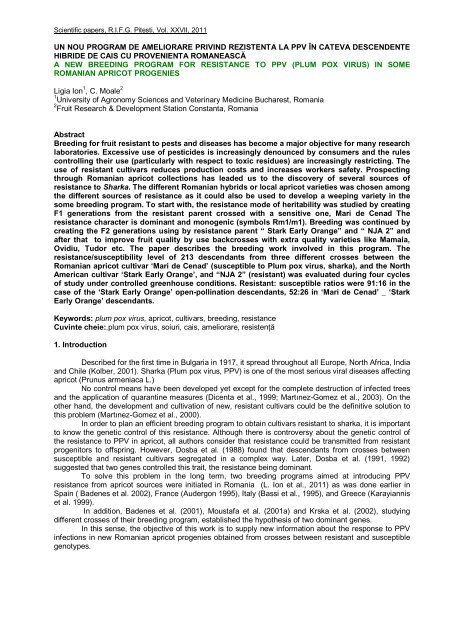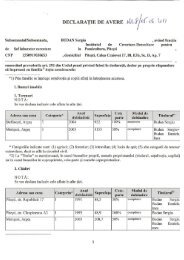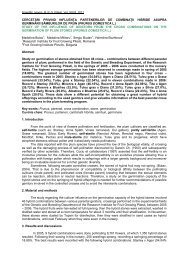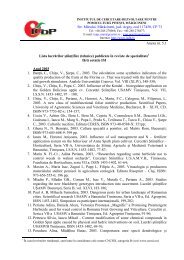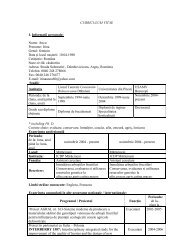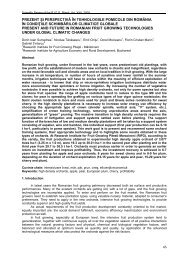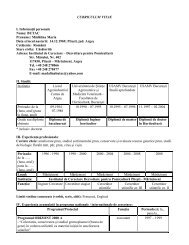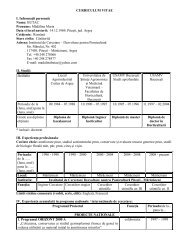05. Lucrare 2 Ligia Ion verificata - ICDP - Pitesti
05. Lucrare 2 Ligia Ion verificata - ICDP - Pitesti
05. Lucrare 2 Ligia Ion verificata - ICDP - Pitesti
Create successful ePaper yourself
Turn your PDF publications into a flip-book with our unique Google optimized e-Paper software.
Scientific papers, R.I.F.G. <strong>Pitesti</strong>, Vol. XXVII, 2011<br />
UN NOU PROGRAM DE AMELIORARE PRIVIND REZISTENTA LA PPV ÎN CATEVA DESCENDENTE<br />
HIBRIDE DE CAIS CU PROVENIENTA ROMANEASCĂ<br />
A NEW BREEDING PROGRAM FOR RESISTANCE TO PPV (PLUM POX VIRUS) IN SOME<br />
ROMANIAN APRICOT PROGENIES<br />
<strong>Ligia</strong> <strong>Ion</strong> 1 , C. Moale 2<br />
1 University of Agronomy Sciences and Veterinary Medicine Bucharest, Romania<br />
2 Fruit Research & Development Station Constanta, Romania<br />
Abstract<br />
Breeding for fruit resistant to pests and diseases has become a major objective for many research<br />
laboratories. Excessive use of pesticides is increasingly denounced by consumers and the rules<br />
controlling their use (particularly with respect to toxic residues) are increasingly restricting. The<br />
use of resistant cultivars reduces production costs and increases workers safety. Prospecting<br />
through Romanian apricot collections has leaded us to the discovery of several sources of<br />
resistance to Sharka. The different Romanian hybrids or local apricot varieties was chosen among<br />
the different sources of resistance as it could also be used to develop a weeping variety in the<br />
some breeding program. To start with, the resistance mode of heritability was studied by creating<br />
F1 generations from the resistant parent crossed with a sensitive one, Mari de Cenad The<br />
resistance character is dominant and monogenic (symbols Rm1/m1). Breeding was continued by<br />
creating the F2 generations using by resistance parent “ Stark Early Orange” and “ NJA 2” and<br />
after that to improve fruit quality by use backcrosses with extra quality varieties like Mamaia,<br />
Ovidiu, Tudor etc. The paper describes the breeding work involved in this program. The<br />
resistance/susceptibility level of 213 descendants from three different crosses between the<br />
Romanian apricot cultivar ‘Mari de Cenad’ (susceptible to Plum pox virus, sharka), and the North<br />
American cultivar ‘Stark Early Orange’, and “NJA 2” (resistant) was evaluated during four cycles<br />
of study under controlled greenhouse conditions. Resistant: susceptible ratios were 91:16 in the<br />
case of the ‘Stark Early Orange’ open-pollination descendants, 52:26 in ‘Mari de Cenad’ _ ‘Stark<br />
Early Orange’ descendants.<br />
Keywords: plum pox virus, apricot, cultivars, breeding, resistance<br />
Cuvinte cheie:.plum pox virus, soiuri, cais, ameliorare, resistenţă<br />
1. Introduction<br />
Described for the first time in Bulgaria in 1917, it spread throughout all Europe, North Africa, India<br />
and Chile (Kolber, 2001). Sharka (Plum pox virus, PPV) is one of the most serious viral diseases affecting<br />
apricot (Prunus armeniaca L.)<br />
No control means have been developed yet except for the complete destruction of infected trees<br />
and the application of quarantine measures (Dicenta et al., 1999; Martınez-Gomez et al., 2003). On the<br />
other hand, the development and cultivation of new, resistant cultivars could be the definitive solution to<br />
this problem (Martınez-Gomez et al., 2000).<br />
In order to plan an efficient breeding program to obtain cultivars resistant to sharka, it is important<br />
to know the genetic control of this resistance. Although there is controversy about the genetic control of<br />
the resistance to PPV in apricot, all authors consider that resistance could be transmitted from resistant<br />
progenitors to offspring. However, Dosba et al. (1988) found that descendants from crosses between<br />
susceptible and resistant cultivars segregated in a complex way. Later, Dosba et al. (1991, 1992)<br />
suggested that two genes controlled this trait, the resistance being dominant.<br />
To solve this problem in the long term, two breeding programs aimed at introducing PPV<br />
resistance from apricot sources were initiated in Romania (L. <strong>Ion</strong> et al., 2011) as was done earlier in<br />
Spain ( Badenes et al. 2002), France (Audergon 1995), Italy (Bassi et al., 1995), and Greece (Karayiannis<br />
et al. 1999).<br />
In addition, Badenes et al. (2001), Moustafa et al. (2001a) and Krska et al. (2002), studying<br />
different crosses of their breeding program, established the hypothesis of two dominant genes.<br />
In this sense, the objective of this work is to supply new information about the response to PPV<br />
infections in new Romanian apricot progenies obtained from crosses between resistant and susceptible<br />
genotypes.
Scientific papers, R.I.F.G. <strong>Pitesti</strong>, Vol. XXVII, 2011<br />
2. Material and method<br />
2.1. Plant material<br />
Plant material evaluated included the Romanian apricot (P. armeniaca L.) cultivar ‘Mari de<br />
Cenad’ (susceptible to PPV) and the North American ‘Stark Early Orange’(SEO) (resistant to PPV) and<br />
the beak crosses (Viceroy x NJA2) x SEO (L.<strong>Ion</strong> et al., 2011). In addition, 163 descendants from three<br />
different crosses were studied: ‘Vioceroy’ _ ‘NJA2’ (93 descendants), ‘Mari de Cenad’ _ ‘Stark Early<br />
Orange’ (70)<br />
2.2. PPV isolate<br />
The PPV isolate assayed was RB3.30, a Dideron type from the collection of the (PPV-D,<br />
provenance of SCDP Bistrita) (Romania) from the plum ‘Tuleu dulce.<br />
2.3. Evaluation of PPV resistance<br />
The resistance of the descendants was evaluated following the method of Badenes et al (2001).<br />
One bud from each descendant was grafted onto a ‘GF305’ rootstock previously infected with sharka.<br />
Three replicates were grafted for each descendant. Plants were placed in a chamber at 7 - 8C for 2<br />
months in order to overcome bud dormancy. Afterwards, they were taken to an insect-proof greenhouse<br />
for 4 months. Symptoms of sharka infection were scored visually, both on the scion and on rootstock<br />
leaves, from 0 (no symptoms) to 5 (maximum intensity of symptoms), 6 weeks after the plants were<br />
placed in the greenhouse. In addition, the optical densities of ELISA-DASI at 405 nm, at 600, using<br />
monoclonal antibodies (Cambra et al., 1994), were recorded to check the presence or absence of the<br />
virus. Samples with OD double that of the healthy control were considered ELISA-positive (Sutula et al.,<br />
1986). Plants were studied for four vegetative cycles (1 year). A descendant was considered susceptible<br />
when at least one replicate in one cycle of study showed symptoms and was ELISA-positive, and<br />
resistant when no replicates showed symptoms or a positive ELISA reaction after four cycles.<br />
3. Results and discussions<br />
The pollinations were started in spring 2008 (photo 1). Number of flowers pollinated, formed<br />
percentage of fruit, number of seeds put to germinate, percentage of plants started in vegetation (photo 2)<br />
are illustrate in table 1.<br />
Regarding the evaluation of the progenitors, ‘Viceroy’ and “Mari de Cenad” behaved as<br />
susceptible and ‘Stark Early Orange’ as resistant to Plum pox virus. after four cycles of study, all the<br />
replicates of ‘Mari de Cenad and Viceroy’ showed sharka symptoms while the replicates of ‘Stark Early<br />
Orange’ did not show any symptoms and were not ELISA-positive The resistant progenitor (‘Stark Early<br />
Orange’) was able to transmit its PPV resistance to the descendants, in agreement with previous results<br />
observed by other authors (Dosba et al., 1992; Dicenta and Audergon, 1998; Dicenta et al., 2000).<br />
Among the 163 descendants evaluated, 61 (37.4%) were susceptible to PPV and 102 (62.25%)<br />
were resistant. A priori, these proportions do not fit to any of the different hypotheses described to date<br />
regarding the genetic control of PPV resistance in apricot (Table 1).<br />
4. Conclusions<br />
To date, the genetic control system of PPV resistance remains unknown, and this is being an<br />
important handicap for the breeding programs. In addition, attempts to locate this trait in the available<br />
maps have not been completely successful, hindering the MAS development. Several reasons may<br />
explain this situation: the strong environmental dependence of PPV resistance scoring (Decroocq et al.<br />
2005), the difficulty into evaluating this trait on large-scale experiments, and the differences in the<br />
methods of evaluation used by research groups (Llácer et al., 2007).<br />
5. References<br />
1. Audergon, J.M., Dosba, F., Karayiannis, I., Dicenta, F., 1995. A method to determine the<br />
susceptibility of apricot to plum pox virus. Acta Hort. 384, 575–579.<br />
2. Audergon J.M., 1995. Variety and breeding. Acta Hort 384:35–45<br />
3. Badenes ML., Martínez-Calvo J., Llácer G., 2002. Estado actual del programa de mejora<br />
genética del albaricoquero en la Comunidad Valenciana. Actas de Horticultura 29:637643<br />
4. Bassi D., Bellini D., Guerriero R., Monastra F., Pennone F., 1995. Apricot breeding in Italy.<br />
Acta Hort 384:47–54<br />
5. Badenes M.L., Moustafa T.A., Lla´cer G., 2001. Resistance to Sharka trait in a family from selfpollination<br />
of ‘Lito’ cultivar. In: Proceedings of the Abstracts XII International Symposium on Apricot<br />
Culture and Decline, Avignon, France, September 10–14.
Scientific papers, R.I.F.G. <strong>Pitesti</strong>, Vol. XXVII, 2011<br />
6. Cambra M., Asensio M., Gorris M.T., Garcı´a J.A., Moya J.J., Lo´pez-Abella D., Vela C., Sanz,<br />
A., 1994. Detection of Plum pox potyvirus using monoclonal antibodies to structural and non-structural<br />
proteins. EPPO Bull. 24, 569–578.<br />
7. Damsteegt V.S., Stone A.L., Luster D.G., Gildow F.E., Levy L., Welliver R., 2001. Preliminary<br />
characterization of a North American isolate of Plum pox virus from naturally infected peach and plum<br />
orchards in Pennsylvania, USA. Acta Hort. 550, 145–151.<br />
8. Decroocq V., Foulongne M., Lambert P., Le Gall O., Mantin C., Pascal T., Schurdi-Levraud V.,<br />
Kervella J., 20<strong>05.</strong> Analogues of virus resistance genes map to QTLs for resistance to Sharka disease in<br />
Prunus davidiana. Mol. Gen. Genomics 272, 680–689.<br />
9. Diaz-Pendo´n J.A., Truninger V., Nieto C., Garcı´a-Mas J., Bendahmane A., Aranda M., 2004.<br />
Advances in understanding recessive resistance to plant viruses. Mol. Plant Pathol. 5, 223–233.<br />
10. Dicenta F., Audergon J.M., 1998. Inheritance of resistance to plum pox potyvirus (PPV) in<br />
‘Stella’ apricot seedlings. Plant Breed. 117, 579–581.<br />
11. Dicenta F., Pe´rez-Campoy P.J., Martı´nez-Go´mez P., Garcı´a-Brunton J., Abad E., 1999.<br />
Plum pox virus situation in Murcia (Spain). Acta Hort. 488, 769– 774.<br />
12. Dicenta F., Martı´nez-Go´mez P., Burgos L., Egea J., 2000. Inheritance of resistance to plum<br />
pox potyvirus (PPV) in apricot, Prunus armeniaca. Plant Breed. 119, 161–164.<br />
13. Dondini L., Costa F., Tataranni G., Tartarini S., Sansavini S., 2004. Cloning of apricot RGAs<br />
(Resistance Gene Analogs) and development of molecular markers associated with Sharka (PPV)<br />
resistance. J. Hortic. Sci. Biotech. 79 (5), 729–734.<br />
14. Dosba F., Lansac M., Maison P., Massonie G., Audergon J.M., 1988. Tolerance to plum pox<br />
virus in apricot. Acta Hort. 235, 275– 281.<br />
15. Dosba F., Denise F., Maison P., Massonie G., Audergon J.M., 1991. Plum Pox Virus<br />
resistance of apricot. Acta Hort. 293, 569–579.<br />
16. Dosba F., Orliac S., Dutranoy F., Maison P., Massonie G., Audergon J.M., 1992. Evaluation<br />
of resistance to Plum pox virus in apricot trees. Acta Hort. 309, 211–219.<br />
17. Fraser R.S., 1990. The genetics of resistance to plant viruses. Ann. Rev. Phytopathol. 28,<br />
179–200.<br />
18. Gao Z.H., Johansen E., Eyers S., Thomas C.L., Noel T.H., Maule A.J., 2004. The potyvirus<br />
recessive resistance gene, sbm1, identifies a novel role for translation initiation factor eIF4E in cell-to-cell<br />
trafficking. Plant J. 40, 376– 385.<br />
19. Guillet-Bellanger I., Audergon J.M., 2001. Inheritance of the Stark Early Orange apricot<br />
cultivar resistance to Plum pox virus. Acta Hort. 550, 111– 115.<br />
20. Hurtado M.A., Romero C., Vilanova S., Abbott A.G., Lla´cer G., Badenes M.L., 2002. Genetic<br />
linkage maps of two apricot cultivars (Prunus armeniaca L.), and mapping of PPV (sharka) resistance.<br />
Theor. Appl. Genet. 105, 182–191.<br />
21. Ko¨lber M., 2001. Workshop on Plum pox. Acta Hort. 550, 249–255.<br />
22. Krska B., Salava J., Pola´k J., Komı´nek P., 2002. Genetics of resistance to Plum pox virus in<br />
apricot. Plant Prot. Sci. 38, 180–182.<br />
23. Lambert P., Audergon J.M., Rubio M., Dicenta F., 2006. QTL analysis for resistance to sharka<br />
disease (PPV-Dideron strain) in apricot using an F1 progeny derived from 2Stark Early Orange. Acta<br />
Hort. 717, 97–100.<br />
24. Levy L., Damsteegt V.S., Welliver R., 2000. First report of Plum pox virus (sharka disease) in<br />
Prunus persica in the United States. Plant Dis. 84, 202.<br />
25. Martı´nez-Go´mez P., Dicenta F., 1999. Evaluation of resistance to sharka in the breeding<br />
apricot program in CEBAS-CSIC in Murcia. Acta Hort. 488, 731– 737.<br />
26. Martı´nez-Go´mez P., Dicenta F., Audergon J.M., 2000. Behaviour of apricot cultivars in the<br />
presence of Sharka (Plum pox potyvirus): a review. Agronomie 20, 407–422.<br />
27. Martı´nez-Go´mez P., Dicenta F., Egea J., 2003. Effect of a traditional control meted on the<br />
spread of sharka in an apricot orchard in Spain. Phytopathol. Mediterr. 42, 161–166.<br />
28. Moustafa T.A., Badenes M.L., Martı´nez-Calvo J., Lla´cer G., 2001a. Studies on Plum pox<br />
(Sharka) resistance in apricot. Acta Hort. 550, 117–120.<br />
29. Moustafa T.A., Badenes M.L., Martı´nez-Calvo J., Lla´cer G., 2001b. Determination of<br />
resistance to Sharka (plum pox) in apricot. Sci. Hort. 91, 57–70.<br />
30. Navra´til M., Safarova D., Karesova R., Petrzik K., 20<strong>05.</strong> First incidence of Plum pox virus on<br />
apricot trees in China. Plant Dis. 89, 338–1338.<br />
31. Provvidenti R., Hampton R.O., 1992. Sources of resistance to viruses in Protyviridae. Arch.<br />
Virol. Suppl. S5, 189–211.<br />
32. Quiot J.B., Labonne G., Boeglin M., Adamolle C., Renaud L.Y., Candresse T., 1995.<br />
Behaviour of two isolates of Plum pox virus inoculated on peach and apricot trees. First’s results. Acta<br />
Hort. 386, 290–294.
Scientific papers, R.I.F.G. <strong>Pitesti</strong>, Vol. XXVII, 2011<br />
33. Ruffel S., Dussault M.H., Palloix A., Moury B., Bendahmane A., Robaglia C., Caranta C.,<br />
2002. A natural recessive resistance gene against Potato virus Y in pepper corresponds to the eukaryotic<br />
initiation factor 4E (eIF4E). Plant J. 32, 1067–1075.<br />
34. Revers F., Le Gall O., Candresse T., Maule, A.J., 1999. New advances in understanding the<br />
molecular biology of plant-potyvirus interactions. Mol. Plant-Microbe Interact. 12, 367–376.<br />
Tables and figures<br />
Photo 1 – The pollinations was started in spring 2008 Photo 2 – The resistant progenies<br />
Table 1 – Results concerning number of plants started in vegetation, obtained from hybrid seeds<br />
No.<br />
Crt<br />
1<br />
2<br />
3<br />
Combination<br />
VT 92.02.52 – NJA<br />
17* (female) x R9 [<br />
53 (male) (Viceroy x<br />
NJA2*)<br />
VT 92.01.05 – NJA<br />
17* X R9 P 53<br />
(Viceroy x NJA2*)<br />
VT 92.02.95 - NJA<br />
17* X R9 P 53<br />
(Viceroy x NJA2*)<br />
No.<br />
of<br />
pollinated<br />
flower/<br />
combination<br />
No. of<br />
formed<br />
fruits/<br />
combination<br />
No<br />
of seeds/<br />
combination<br />
% of<br />
formed<br />
fruits<br />
No<br />
of<br />
plants<br />
started in<br />
vegetation<br />
7,005 95 65 1.35 13<br />
5,730 89 77 1.55 32<br />
3,474 58 23 1.66 18<br />
4<br />
VT 92.02.91 - NJA<br />
17* X R9 P 53<br />
(Viceroy x NJA2*)<br />
4,927 65 33 1.30 30<br />
5<br />
R10 P79 (Viceroy x<br />
NJA2*) X Tabriz<br />
370 13 0 0 0<br />
6 R10 P79 X Traian* 450 23 0 0 0<br />
7<br />
V5 – VT 30/40 Mari<br />
580 26 7 4.48 7<br />
8<br />
9<br />
de Cenad x (SEO *)<br />
V6 – VT 12/13 –<br />
MOONGOLD X NJA<br />
42*<br />
3,099 68 35 2.19 31<br />
VT 4/73 –<br />
VIVAGOLD X NJA<br />
42*<br />
4,813 75 37 1.55 32<br />
Total 30,448 482 277 1.58 163
Scientific papers, R.I.F.G. <strong>Pitesti</strong>, Vol. XXVII, 2011<br />
Figure 1.<br />
8000<br />
7000<br />
6000<br />
5000<br />
4000<br />
3000<br />
2000<br />
1000<br />
0<br />
Figure 2.<br />
90<br />
80<br />
70<br />
60<br />
50<br />
40<br />
30<br />
20<br />
10<br />
0<br />
Ratio between no. of pollinated flowers and no. of formed fruits per<br />
combination<br />
1 2 3 4 5 6 7 8 9<br />
no of pollinated flowers<br />
No. of formed fruits/ combination<br />
Ratio between no. of plantated seeds and no. of plants started in<br />
vegetation<br />
1 2 3 4 5 6 7 8 9<br />
combination<br />
No. of seeds/combination<br />
No. of plants started in vegetation


